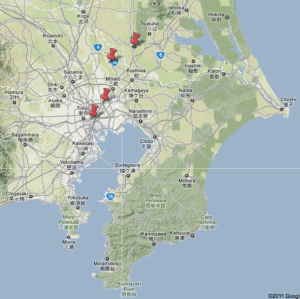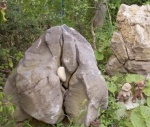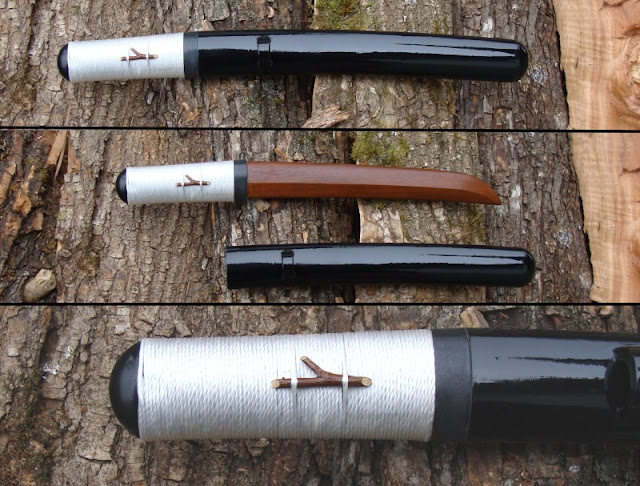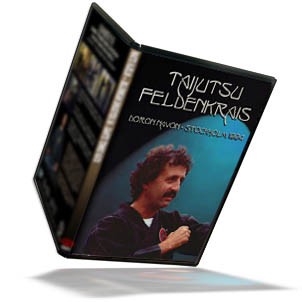From The Magick & The Mundane » Bujinkan by Shawn Gray
I. Recap
In the first part of this article we looked at some early uses of the term “demon” in the West in order to help us more fully understand some of the things that Sensei refers to when he talks about the demon motif in connection with the Bujinkan martial arts tradition of Kukishin-ryū (九鬼神流). We also looked into some psychological principles derived from the demon idea and how those principles can be used to make our lives happier and more balanced. In this final part of the article, we will look at principles of Japanese geomancy (fuu-sui, 風水) related to the demon motif, and give some very brief hints as to some ideas for application of these principles to the Kukishin-ryū taijutsu techniques Kimon (鬼門) and Ura Kimon (裏鬼門).
II. Geomancy
Geomancy is an ancient earth-based system of divination. The most commonly-known Eastern method of geomancy is the Chinese system of Feng-shui (pronounced fung-shway). The Japanese equivalent, known as “Fuu-sui” uses the same kanji characters as the Chinese system – the character for wind and the character for water (風水). The topic of geomancy as a whole goes far beyond the scope of this article, but in very basic terms it refers to the use of geography (both directions and location/placement of geographical features) in divination.

Edo Castle -> Ayase -> Noda -> Mitsukaido
A) SouthWest to NorthEast
One of the geomantic aspects which is connected with Kukishin-ryū is the cardinal direction known as Kimon (鬼門) – “Demon Gate.” This term originates in the Sengaikyo document, which was written in China during Japan’s Warring States Period, the Sengoku-jidai, “a time of social upheaval, political intrigue, and nearly constant military conflict that lasted roughly from the middle of the 15th century to the beginning of the 17th century”. Most Bujinkan practitioners are probably more familiar with the pressure point (kyusho, 急所) of the same name, which is located on the chest muscle structure a few centimeters above the nipple. This pressure point actually derives its name from a direction, or trajectory, on the Fuu-sui compass – the direction of Kimon (鬼門), which is associated with the Northeast. Traditionally, the center of the Fuu-sui compass is located at the political center the land. In the case of Japan, from the Edo Period onward, this was Edo Castle (Edo, 江戸, is the old name of Tokyo), so the direction of Kimon in this case would be a line drawn in a Northeast direction from Edo Castle. Moving along the line North-East, one moves towards the Kimon. One interesting point to note before moving on is that Hatsumi Sensei’s weekly Tuesday classes at the Tokyo Budokan are in Ayase, which lies in the Northeast direction from Edo Castle, as does the Bujinkan Honbu Dojo in the town of Noda if you move farther out in the direction of the Kimon, as does Hatsumi Sensei’s home in Mitsukaido if you move yet farther out from the center along that same Northeast line. (This is not an exact straight line of course, but close enough to make it interesting.)
B) Geopolitical Expansion of the Early Japanese

Were Tengu actually early Russians?
Another interesting point comes when we look at the overall geographic orientation of the Japanese islands themselves – they are generally oriented in a Southwest – Northeast configuration. One image comes to mind of the early invaders of these islands (the ancestors of modern Japanese) fighting the native Ainu population back up to their retreat in the northern island of Hokkaido as they fought their way up from the Southwest corner of the island chain up to the Northeast – a procession from the Ura Kimon to Kimon. Yet another image that comes to mind is that of the red-faced, big-nosed Tengu demon which, according to one theory, may originate from early skirmishes with or sightings of the long-nosed, red-faced peoples of what is now Russia as the Japanese invaders moved up into the Northeast end of the island chain. The reason that the Kimon was drawn from SouthWest to NorthEast may have been because, to the ancestors of the modern Japanese people who settled the islands, expanding from the SouthWest to the NorthEast, their rivals and enemies would have been the Ainu and the inhabitants of what is now Russia, to the far NorthEast. This is the direction from which their enemies would have attacked, and the direction in which the ancient Japanese had to expand in order to secure the islands for themselves. Another, more modern, example of the term is used in relation to the general Northeast direction of the Joban Line, a Japan Rail train line. This line is sometimes referred to as “the railway Kimon” because of its extension out from central Tokyo in a Northeast direction.
C) Sensei’s Garden

SW Corner

NE Corner
During a visit to Sensei’s country home in 2004, he treated me to a tour of his garden, pointing out the significance of each object not only in and of itself, but in its relationship to the objects around it and its position in the garden as a whole. One of the impressive features of this garden is an imposing stone monument located at the Southwest corner. Engraved into the stone are the characters for “Kuki”, and mounted upon it is a large demon mask. This stone demon monument stands at the Southwest corner, as a guard of the garden. Conversely, at the Northeast corner of the garden, almost hidden away in the grass behind a greenhouse, sits a rather unimposing rock with a couple of terra-cotta figurines standing in front of it. When asked if I understood this, I had to scratch my head and admit that I didn’t really see the significance. Sensei then made a joke related to the shape of the rock, which I then realized bore a striking resemblance to female genitalia. The clay terra-cotta figurines had exaggerated genitalia as well, marking this corner of the garden as a place of fertility and creation. Sensei said that traditionally, when a child was born to a family, they would fire off arrows into the Northeast in celebration. The juxtaposition of the opposing corners was quite striking – on one side, the ferocious guardian; on the other, the generative forces at work.
III. Kimon in Taijutsu

Sweden 2005 - Photo by Mats Hjelm
The Kimon and Ura Kimon techniques of the Kukishin-ryū tradition come from its Dakentaijutsu section. This section of the tradition’s curriculum deals with grappling in Japanese samurai armour, known as yoroi (鎧). As one can imagine, and as anyone who has actually worn and moved around in it knows very well, Japanese armour is heavy, awkward, and restricting in and of itself, let alone in a battlefield situation where there would have been weapons, opponents, and obstacles all around. Once someone in armour fell to the ground, it was a difficult and dangerous exercise to get up again, and in many situations one was probably considered quite lucky if he were able to get back onto his own two feet alive. Thus, it was paramount for one to maintain his own balance while fighting in armour, and equally advantageous to study the ways of unbalancing an armoured opponent.
In the first part of this article, we discussed the classical (Platonic) idea of demons and how the generic term (daemon or daimon) can refer to a part of the psyche which is neither good nor evil. Long after Plato, in Medieval Europe, several grimoires were written (such as The Lesser Key of Solomon) that describe demons as unbalanced (and unbalancing) forces. From a taijutsu perspective, if we interpret the idea of Kimon (“Demon Gate”) as a gateway for unbalancing force, its application to armoured taijutsu movement takes on a new meaning – both with regard to unbalancing someone else and to maintaining one’s own balance as well. (Also remember to think about this in terms of psychological balance…) The Kimon is an extremely effective point to use when taking the balance of someone in armour. It is a point where, when force is properly applied (right amount, right angle, etc.), the opponent’s balance can be taken quite easily. And as mentioned above, an unbalanced opponent is pretty close to a dead opponent, especially if he is wearing heavy armour.

Noguchi Sensei in Yoroi
When practicing in the dojo, the Kimon kyusho pressure point on the chest is often attacked with a painful thumb strike known as a boushiken (棒指拳). However, looking at the technique from a classical perspective where yoroi armour is being worn, the Kimon would be covered by the yoroi and thus protected from the thumb strike. In fact, striking with the thumb to this area in such a case would more likely damage the thumb of the striker than the Kimon of the opponent. Because of this, when looking at the Kimon and Ura Kimon techniques of Kukishin-ryū, it is best to not think only of the Kimon kyusho itself, but to consider the direction, or line of balance, in which the defender enters the attacker’s space and the direction in which the attacker is taken off balance.
Actual taijutsu techniques are much better explored in the physical realm under the guidance of a qualified instructor than in the realm of text on web blogs, so I am not going to go into a description of the techniques here, but if you mentally superimpose the fuu-sui compass directions on either the horizontal or vertical planes when practicing these techniques, you will be sure to notice interesting correlations to the Northeast/Southwest directions and the concepts of Kimon and Ura Kimon. The picture on the right above is one that I took of Noguchi Sensei wearing armour at a Daikomyosai a few years ago. I’ve drawn an arrow on the photo to point out the NorthEast and SouthWest “corners of balance”. If we were squaring off with an opponent wearing armour like this, the Kimon would be at his left chest/shoulder, in the direction of the arrow pointing to the NE. By striking or pushing in this direction, upward against the chest/shoulder, the opponent’s balance would be taken to his left back side – the Kimon direction. Conversely, if we were to take the opponent’s right wrist or forearm and draw it forward and down, in the direction of the SW, the SouthWest direction of the compass, his balance would be broken to his right front side. This would be an example of the Ura Kimon direction. I hope this illustration helps you to understand Kimon vs. Ura Kimon in this context.
Best wishes in your study of Kukishin-ryū taijutsu, and I hope you have found this two-part article on the demon motif in Kukishin-ryū to have been helpful and informative.


…



































